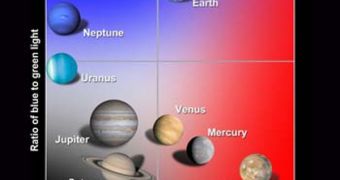Astronomers believe they may have just discovered a new way of identifying Earth-like planets around distant stars, by looking for the type of light these celestial bodies reflect.
The new technique is based on recent data that the NASA EPOXI mission collected of the planets in our solar system as it was chasing down Comet Hartley 2.
Two telescopes and a spectrometer aboard the re-purposed spacecraft imaged all the eight planets, based solely on how much blue and red light they reflected back into space.
Researchers were surprised to discover that the differences between planets were a lot more significant than they had anticipated. Earth and Neptune, for example, are very similar as far as their place on the new table goes.
Mars, on the other hand, is all isolated in its corner, as the planet that reflects back most red light that falls on it. Given that this investigations method has been successfully used in these scenarios, experts see no reason why it couldn't be applied to outer space as well.
The field of exoplanetary research could benefit extensively from such a study capability, especially considering that even the most advanced telescopes out there today cannot image exoplanets directly and easily.
The bodies appear as mere pecks of light on highly-focused images, and researchers say that the radiation could be used to gain additional insight into how the planet actually looks like.
All that is needed for the new approach to work is the development of observations technologies that would allow for the individual light of distant planets to be collected.
The new approach could then be applied on those datasets, enabling astronomers to determine the existence of potential Earth-like planets elsewhere in the Milky Way or the Universe.
“Eventually, as telescopes get bigger, there will be the light-gathering power to look at the colors of planets around other stars,” explains Lucy McFadden, an astronomer at the University of Maryland.
She conducted the new investigation together with Carolyn Crow, a graduate student at the University of California in Los Angeles (UCLA), Universe Today reports.
Their colors will tell us which ones to study in more detail. It is Earth’s atmosphere that dominates the colors of Earth. It’s the scattering of light in the ultraviolet and the absence of absorption in the infrared,” the astronomer adds.

 14 DAY TRIAL //
14 DAY TRIAL //